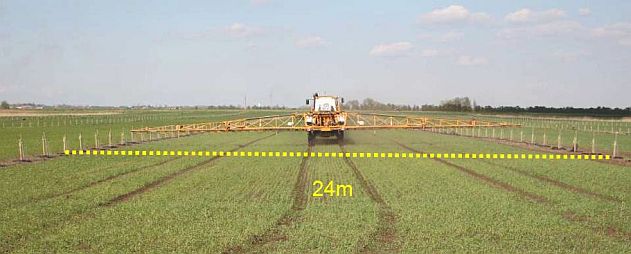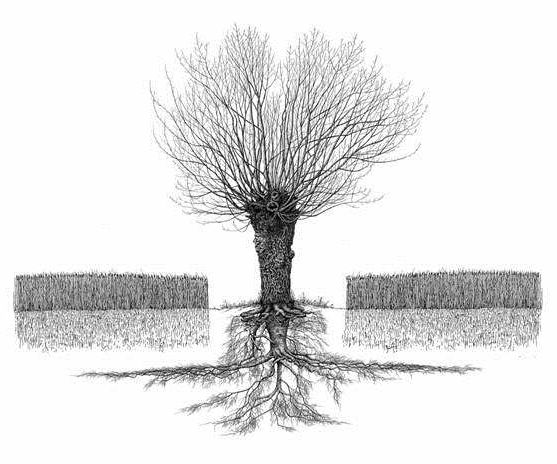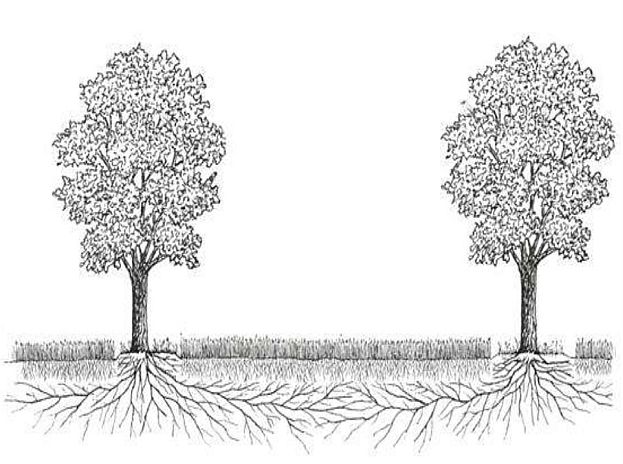By Molly Shaw
Imagine our farming landscape. All that greenery of pasture and crops is a thin layer above the soil supported by some roots thrust shallowly into the ground. Much of our arable landscape was once crowded with tall trees, decked out with epiphytes, and carpeted with bush and moss—a complex three-dimensional, highly productive growing environment that we’ve flattened to meet our agricultural needs. But with the simplification of the ecosystem for agriculture we have also cut down on the land’s potential for growth.
Look upwards and imagine the spreading leaves of a tall tree. Look downwards and imagine strong roots foraging 1-3 meters below the soil surface. Now imagine a farming system where you can benefit from the reach of those plants—a system that is more productive and profitable than the one we’re used to. And yes, it is feasible. It’s called Agroforestry.
Now if you’re at all like me, the term “Agroforestry” conjures up pictures of enthusiastic hippies puttering around small plots of trees, cultivating mushrooms and not caring a twit about profit. But around the globe, other countries have been using trees judiciously in their farming systems for decades while still maintaining or increasing yields of pasture and arable crops and the mechanization/efficiency that we’ve come to enjoy. Stephen Briggs, a UK farmer and researcher, won a Nuffield Scholarship and travelled to many of these sites to learn how the systems work and how feasible they would be for UK farmers to adopt [2] https://www.nuffieldscholar.org/reports/gb/2011/agroforestry-new-approach-increasing-farm-production . With the considerable similarities in NZ and UK farming systems, most, if not all of the lessons apply equally to NZ agriculture and horticulture.
The Case for Agroforestry Being Feasible
- The scene: high value trees, straight wide rows with crops beneath;
- amenable to modern mechanization;
- Productivity;
- Profitability;
- Used extensively in other parts of the world.
What does this modern highly productive agroforestry look like?
First off, the trees are actually quite sparse. Most successful worldwide agroforestry systems have tree densities of around 100 trees per hectare, with the cropping or pasture area between trees. The best compromise between tree growth and crop shading seems to be with row widths of 24-48 meters and tree spacings within a row of 5-15 meters. As a general rule, when the tree height reaches the row width, the trees cast enough shade to decrease the yield of the alley crop—and this observation seems to hold true with a wide variety of tree and crop/pasture combinations. At low tree densities, crop productivity (and therefore annual income) is maintained, while at the same time timber for future harvesting is being accumulated.


Images courtesy of Stephen Briggs
How does productivity compare to our normal agricultural fields?
This is the amazing part. The productivity of a well-planned agroforestry system is actually quite a bit higher than either trees or pasture/arable crops planted alone, on the order of 130-140% higher on average over the life of the trees. This is possible because trees can occupy different niches in the environment than crops. In a field of wheat, for instance, roots can reach a depth of 40-50 cm and the plant leaves reach less than a meter high. In a tree plantation, tree roots occupy that top layer of soil, plus a little extra depth, while the leaves reach many meters into the air, height depending on tree species and age.
In an agroforestry planting the crop roots still occupy the top 40-50 cm, but tree roots shift lower, occupying the soil zone 1-3 meters deep. This is partially due to competition from the arable crop and partly due to root pruning by cultivation / tillage, but the outcome is that more of the soil profile is mined by plant roots than in either system alone. Tree roots can use nutrients that leach out of reach of the arable crops, and can mine water from lower depths as well. Farmland nitrogen losses can be reduced by 50% under agroforestry compared to monoculture. Think of the potential benefit to farmers who are under increasing pressure to reduce nitrogen leaching and conserve water.


Images courtesy of Stephen Briggs
Happy and productive livestock
There are some long held beliefs in farming circles that trees and stock don’t mix, for such reasons as animals lounging under trees don’t graze as much, and stock camps concentrate nutrients. However, most of these beliefs are founded on suspicion not research, and, as the science catches up, many of these myths are being busted. For example cattle with access to shade actually grazed 30-40 minutes longer than cattle without, and heat stress is a major issue for lost stock productivity [1, 3]. Agroforestry systems also don’t have the same level of concentrated stock camps found under big dense shelterbelts, conversely they can be used to better manage dung deposition, keeping it away from areas prone to leaching such as water courses. Agroforestry systems can therefore considerably increase stock performance and health, and redistribute nutrients making for even greater gains.
Right, productivity is all well and good, but how does profitability compare to forestry and agriculture systems that we’re familiar with?
This is also good news, believe it or not. When trees are planted at that low density discussed above and the tree species chosen are of high value (high grade timber, for instance), the profitability of the system is greater than either crop grown alone. This does come with a caveat though. The farmer has to take the long-term view of profitability. If the trees take 15 or 20 years to mature to harvest, the profit each year is expected to be slightly lower (3% is one estimate) than the arable crop planted by itself, with greater sacrifices in profitability in the years closer to tree maturity. Then there’s a big “windfall” of profit during the tree harvest period that more than makes up for the earlier losses. In a well planned system, trees can be progressively introduced and then harvested sequentially so once the financial benefits flow, they flow continually.
The trees chosen for a profitable agroforestry system must be high value. In China, the tree of choice is paulownia, a fast-growing timber tree that fixes nitrogen, grown in combination with wheat. More recently poplar has become popular, as the market for paulownia timber became saturated. In France, black walnut is the most popular choice because of its high timber value, although other hardwoods are used as well.
Are these numbers just coming from researchers’ hypotheses and suppositions? How well tested are these generalizations?
It turns out that there are many regions in the world with well established agroforestry systems popularly adopted by farmers. Trees are grown with wheat extensively in north-central China, to the tune of 3 million hectares. Both Canadian and the United States governments recognise the value of agroforestry and are building support into their legislation. In central Spain and southern Portugal agroforestry occupies 3.5 million ha, nearly 3% of the land area, and has created some of the cultural landscapes such as the ‘Dehesa’ and ‘Montado’. In France there are also has a number range of examples cited by Stephen Briggs successful agroforestry farms. However, In many much of the rest of the EU, including the UK, farm subsidy payments limit agroforestry adoption because agroforestry doesn’t fit into the established categories of government-supported cropping systems. However, the EU bureaucracy is increasingly recognising the value of agroforestry and altering the rules to facilitate it. Here in New Zealand, with no direct government payments to farmers, producers are not limited by bureaucracy, only their imagination!
There are more reasons to consider an agroforestry system than simple productivity and profit numbers. Increasing the biodiversity of our landscape is the mantra of not only environmentalists, but also specialists in pest biocontrol and carbon sequestration proponents. As already mentioned, incorporating trees in a cropping or pasture system can reduce nitrogen leaching by 50%. Trees in the landscape slow down wind, reducing evaporative water loss from the crops nearby. Canterbury farmers could think of agroforestry as shelter belts that turn a profit!
In addition the recent nor’westers that have destroyed a considerable number of center pivot irrigation systems, are, according to climate scientists, a return to normal after a decade long lull. If correct, then shelter in Canterbury is going to become increasingly important, as pointed out by old timers who recall the massive government shelter planting programs in the 50s and 60s, the legacy of which are many of the now massive gum tree lines. While shelter around farm boundaries will help, clearly pivots and tree rows within a farm are incompatible. One solution to this currently being investigated is the use of buried drip tape purpose-designed for pasture. While the benefits of drip are well understood in horticulture, where in places with hot climates, such as Israel and California, it is the dominant irrigation technique, there could be significant benefits for drip over pivots, plus, drip and agroforestry are well matched. If pivots continue to be damaged by wind across the plains of Canterbury and potentially Hawkes Bay, then alternatives will be required: agroforestry and drip could be an answer.
It will take creativity to think outside the monoculture box, but New Zealand farmers are not lacking in adaptability. Gaze up above the grassy pasture, think down to the shallow water table, and imagine the potential if we were to farm that third dimension.
Additional information
This has been updated in Feb 2023
The Agroforestry Research Trust (UK) https://www.agroforestry.co.uk/
Agroforestry Innovation Network (AFINET) https://agroforestrynet.eu/afinet/
AFINET Handbook https://agroforestrynet.eu/
International Center for Research in Agroforestry (ICRAF) http://www.ciesin.org/IC/icraf/ICRAF.html
Association for Temperate Agroforestry (AFTA) https://www.aftaweb.org/
World Agroforestry https://www.worldagroforestry.org/
References
1. Betteridge, K., Costall, D., Martin, S., Reidy, B., Stead, A., and Millner, I. Impact of shade trees on angus cow behaviour and physiology in summer dry hill country: grazing activity, skin temperature and nutrient transfer issues. in Advanced Nutrient Management: Gains from the Past – Goals for the Future. Occasional Report No. 25. . 2012. Palmerston North, New Zealand: Fertilizer and Lime Research Centre, Massey University. http://www.massey.ac.nz/~flrc/workshops/12/Manuscripts/Betteridge_1_2012.pdf
2. Briggs, S., Agroforestry a new approach to increasing farm production: A Nuffield Farming Scholarships Trust Report. 2012. https://www.nuffieldscholar.org/reports/gb/2011/agroforestry-new-approach-increasing-farm-production
3. Verkerk, G., In summer, shade rules the science behind why trees help maintain dairy productivity. New Zealand Tree Grower, 2009. February. https://www.nzffa.org.nz/farm-forestry-model/resource-centre/tree-grower-articles/february-2009/in-summer-shade-rules-the-science-behind-why-trees-help-maintain-dairy-productivity/
